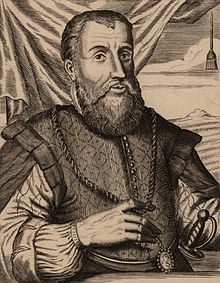Diego Velázquez de Cuéllar
- For the Spanish painter, see Diego Velázquez.
Diego Velázquez de Cuéllar (1465 - 1524) was a Spanish soldier and colonial administrator (a Conquistador).He conquered and governed Cuba for Spain. He is often called Diego de Velázquez by Dominican historians (that is the name used in the Appleton's Cyclopedia).

He was born in Cuéllar, near Segovia, Spain. He came to America in the second voyage of Christopher Columbus in 1493. He spent 17 years in the Hispaniola, living most of the time in the southwestern region of the island.
He worked together with the Spanish governor Nicolás de Ovando in the fight against the Taíno Indians of the region. He founded and governed several towns: Azua de Compostela (1504),[1] San Juan de la Maguana (1503),[2] Bánica (1504), Salvatierra de la Sabana (1504, now Les Cayes, Haiti),[3] Santa María de la Verapaz (near the present Port-au-Prince, Haiti), Villanueva de Yáquimo (now Jacmel, Haiti).
In 1511, he left from Salvatierra de la Sabana with 300 men and three or four ships to the island of Cuba to conquer that island. He was the first governor of the island and he founded several cities, Nuestra Señora de la Asunción de Baracoa (the first European city in Cuba and its first capital) in 1511, San Salvador del Bayamo (1513), Santiago de Cuba in 1514 and Havana in 1515.[4]
In 1517 he sent Juan de Grijalva to explore the coast of Mexico and in 1518 he sent Francisco Hernández de Córdoba to explore the coast of Yucatán. Then in 1519 he sent his secretary, Hernán Cortés, to conquer Mexico with about 450 soldiers but when Cortés got to México (in Veracruz), he broke all relations with Velázquez.
Diego Velázquez de Cuéllar died in Santiago de Cuba in 1524.
References
change- ↑ Matos González, Ramiro (1995). Azua Documental (y Apuntes Históricos) (in Spanish). Santo Domingo: Editora Alfa & Omega. p. 120.
- ↑ Garrido, Víctor (1971). Espigas históricas (in Spanish). Santo Domingo: Academia Dominicana de la Historia, vol XXXI. p. 330.
- ↑ Incháustegui, J. Marino (1955). Historia Dominicana, Tomo I (in Spanish). Ciudad Trujillo, República Dominicana: Impresora Dominicana. p. 72.
- ↑ Rodríguez, C. Armando (1976). Geografía de la Isla de Santo Domingo y Reseña de las demás Antillas (in Spanish). Santo Domingo: Sociedad Dominicana de Geografía, Vol. XI (Reprinting). p. 212.
Other websites
change- (in Spanish) Enciclopedia Libre Universal Archived 2005-02-11 at the Wayback Machine
- (in Spanish) Biography Archived 2006-10-22 at the Wayback Machine, with a bibliography
- Short biography
- (in Spanish) Encarta Archived 2007-03-09 at the Wayback Machine